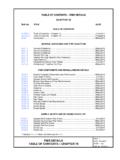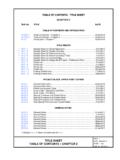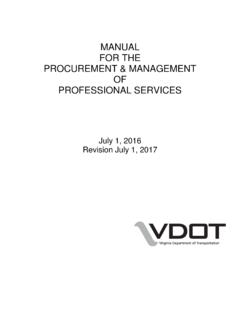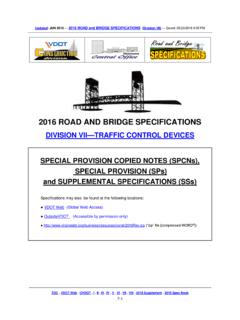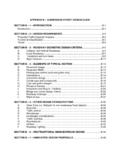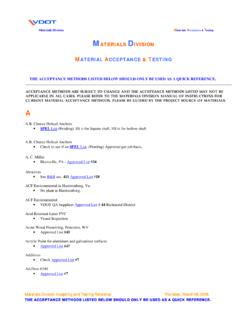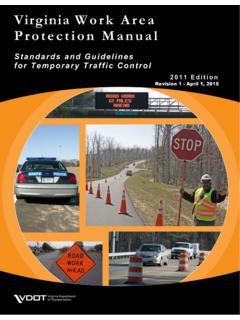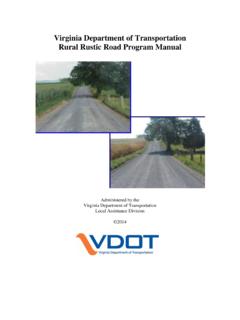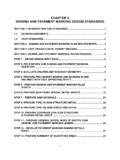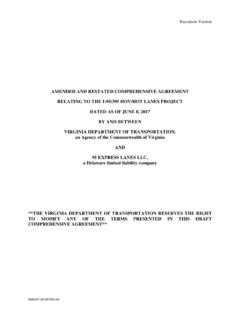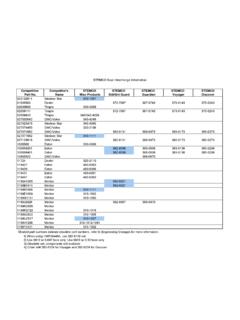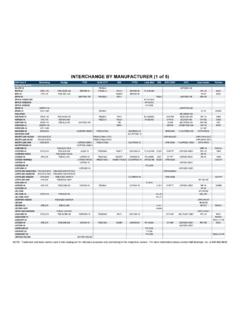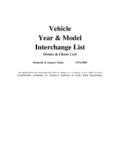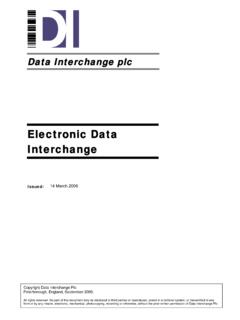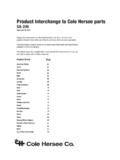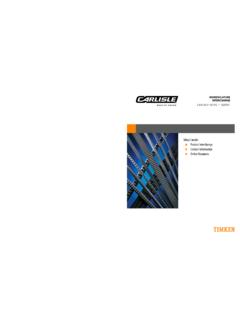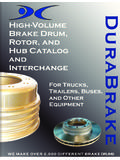Transcription of Diverging Diamond Interchange (DDI)
1 Develop Alternative Intersection Informational GuidesDiverging Diamond Interchange (DDI)August 27, 20141 Presentation Outline Introduction Project Background, Objectives, and Team Overview of Alternative Intersections Overview of Diverging Diamond Interchange Additional Resources2 Introduction Today s Presenters Jeff Shaw, FHWA Pete Jenior, Kittelson & Associates, Inc. Dr. Bastian Schroeder (DDI co author) Chris Cunningham (DDI co author) Webinar Overview3 Presentation Outline Introduction Project Background, Objectives, and Team Overview of Alternative Intersections Overview of Diverging Diamond Interchange Additional Resources4 Project Background Past Alternative Intersections/Interchanges.
2 Informational Report (AIIR) Published by FHWA in 2010 Provided a summary of the range of intersection forms professionals could consider5 Project Background Every Day Counts (EDC) Initiative Designed to identify and deploy innovation aimed at reducing the time it takes to deliver highway projects, enhance safety and protect the environment. For this project Assisting efforts to bring renewed focus to alternative intersections create easy to use guides and supplementary webinar materials Foster a wider implementation of these EDC intersection and Interchange designs by state highway and local road agencies6 Project Objectives Develop materials that will aid highway planners and designers Facilitate the deployment of four (4) Alternative Intersection designs.
3 Diverging Diamond Interchange (DDI) Displaced Left Turn Intersection (DLT) Restricted Crossing U Turn Intersections (RCUT) Median U Turn Intersection (MUT) Replace the 2010 AIIR information with current research and findings7 Project Objectives Guide Outline consistent for all Guides Chapter 1 Introduction Chapter 2 Policy and Planning Chapter 3 Multimodal Considerations Chapter 4 Safety Chapter 5 Operational Characteristics Chapter 6 Operational Analysis Chapter 7 Geometric Design Chapter 8 Signal, Signing, Marking and Lighting Chapter 9 Construction and Maintenance Appendices8 Project Objectives Focus of the Guides Policy and planning considerations Multimodal considerations Public outreach materials and resources Current safety research and operational practices While still providing Geometric design guidance Signals, signing and pavement marking details Construction considerations9 Project Team Overall Project Management Federal Highway Administration Virginia Tech Transportation Institute Kittelson & Associates, Inc.
4 (Brian Ray, Principal Investigator) Diverging Diamond Interchange Dr. Bastian Schroeder, ITRE at State University Chris Cunningham, ITRE at State University Displaced Left Turn Intersection Hermanus Steyn, Kittelson & Associates, Inc. Median U Turn Intersection Jonathan Reid, Parsons Brinckerhoff Restricted Crossing U Turn Intersection Dr. Joe Hummer, Wayne State University10 Presentation Outline Introduction Project Background, Objectives, and Team Overview of Alternative Intersections Overview of Diverging Diamond Interchange Additional Resources11 Overview of Alternative Intersections Provide potential to improve safety and reduce delay at a lower cost than traditional solutions Often unfamiliar to transportation practitioners due to limited existing applications Require specific planning and policy considerations for all users Create the need for public involvement and driver education12 Planning Considerations Alternative intersection evaluations may vary depending on the stage of the project development process Planning level design evaluations may not
5 Require a detailed level of analysis Evaluations should be comprehensive enough to answer key project questions for each unique project context13 Pedestrian and Bicycle Accommodation Pedestrians may be required to cross multiple lanes with potential multi stage crossings Some maneuvers through intersection are counterintuitive for pedestrians and bicycles Bicyclists are accommodated on the road or off street in shared use paths Evaluate trade offs to address various user needs14 Stakeholder Outreach The implementation may require extensive public outreach and educational meetings to familiarize the public with the unusual geometry.
6 Outreach should be directed at all usersSource: Utah Department of TransportationSource: North Carolina Department of TransportationSource: Utah Department of Transportation15 Types of Alternative Intersections Displaced Left Turn Intersection Continuous Flow Intersection (CFI) Crossover Displaced Left Turn Intersection Median U Turn Intersection Median U turn Crossover Boulevard Turnaround Michigan Loon ThrU Turn Intersection Restricted Crossing U Turn Intersection Superstreet Intersection J turn Intersection Synchronized Street Intersection Diverging Diamond Interchange Double Crossover Diamond (DCD) 16 Presentation Outline Introduction Project Background, Objectives, and Team Overview of Alternative Intersections Overview of Diverging Diamond Interchange Additional Resources17 Poll Are there Diverging Diamond Interchanges in your state?
7 18 Diverging Diamond Interchange Overview of Interchange Type Multimodal Considerations Safety Considerations Operations Geometric Design Signing, Striping and Lighting Construction19 Diverging Diamond Interchange An alternative to the conventional Diamond Interchange or other alternative Interchange forms. A DDI is different from a conventional Diamond Interchange directional crossovers on either side of the Interchange eliminates the need for left turning vehicles to cross the paths of approaching through vehicles. Improves the operations of turning movements to and from the freeway facility Reduces the number and severity of vehicle to vehicle conflict points20 Diverging Diamond Interchange Schematic Overview of Interchange features21 Multimodal Considerations Generators in the vicinity of the Interchange Residential areas, employment centers, parks, downtown areas, shopping, and restaurants Desire lines of non motorized traffic Across the arterial street versus along the arterial street (or both)
8 Proximity of transit stops or expected transit lines through the DDI Freeway or cross street Ages of expected users To determine presence/absence of children, elderly, or individuals with disabilities at the interchange22 Pedestrian Accommodations Center Walkway versus Outside Pedestrian Facilities Conflict Points Free Flow Left turn onto Freeway Communicating Direction of Traffic Pedestrian Channelization and Wayfinding Pedestrians with Disabilities23 Pedestrian Center WalkwayMO13 DDI in Springfield, MOSource: ITRE24 Pedestrian Outside WalkwayDorsett Road DDI in Maryland Heights, MOSource: ITRE25 Free-Flowing or Accelerating ConflictStopped or Decelerating ConflictFree-Flowing or Accelerating ConflictStopped or Decelerating ConflictPedestrian Vehicle Conflict Points 8 Conflict Points 2 free/flow or accelerating 6 stopped or decelerating 12 Conflict Points 4 free/flow or accelerating 8 stopped or decelerating26 Pedestrian Focused DDI Design27 Bicycle Accommodations Three Options A marked bicycle lane throughout the DDI A separated bicycle way or multi use path No special bicycle accommodations, which would mean that bicyclists use the vehicular travel lane or pedestrian walkways 28 Option 1.
9 Marked bicycle lane throughout the DDI Source: Oregon DOT29 Option 2: Bicyclists on Multi-Use PathSource: ITRE30 Option 3: No special bicycle accommodationsSource: ITRE31 Right Side Bike Lane32 Transit Accommodations Transit benefits reduced number of signal phases and reduced delays Transit stops within Interchange are not recommended unless a wide median is provided Requires special consideration for transfer terminals (freeway express to local system) DDI does not allow freeway to freeway through movement There are opportunities to include light rail through the DDI with preference for inside lanes33 Safety Considerations Conflict Points Crossing Merging Diverging Total Conventional Diamond 10 8 8 26 Diverging Diamond 2 6 6 14 34 Safety Considerations General Safety Concerns Right turn at off
10 Ramp Left turn at off ramp Heavy Vehicles Wrong way maneuvers Pedestrian and bicycle safety No CMFs exist for DDIs at this time CMFs will be provided in a future edition of the Highway Safety Manual and on FHWA s CMF Clearinghouse. The CMF will likely apply to the entire Interchange facility and not individual crossovers. 35 Operational Considerations Queue Spillback Demand Starvation Signal Progression Lane Utilization Saturation Flow Rates Speed Profiles Right Turn at Off Ramp Heavy Vehicles Pedestrian Effects on Capacity Ramp Area Merge Capacity Ramp Metering Impacts Weaving Maneuvers Emergency Vehicles36 Operational Principles37 Operational Zones DDI s have five unique operational zones, each with key operational considerations38 Operational Zone Considerations Approach Zone (A) Queue spillback, demand starvation and signal progression.
